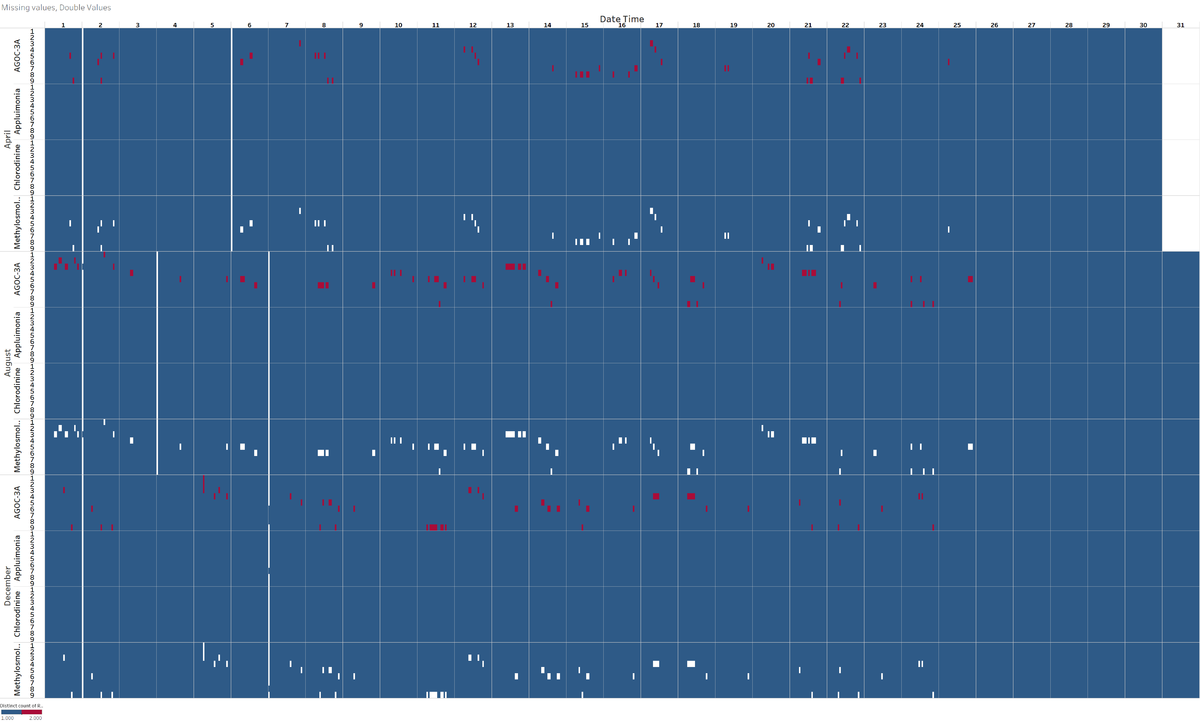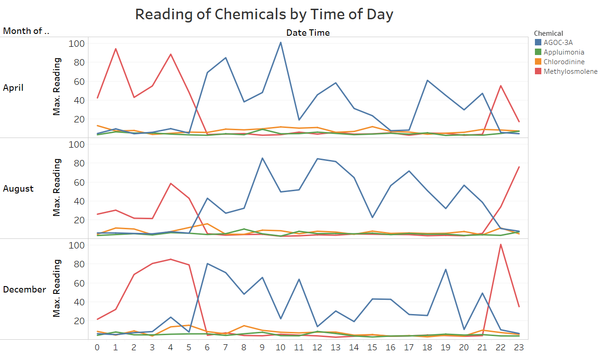Difference between revisions of "ISSS608 2016-17 T3 Assign TEN KAO YUAN MC2"
| Line 46: | Line 46: | ||
==Sensors== | ==Sensors== | ||
'''Characterize the sensors’ performance and operation. Are they all working properly at all times? Can you detect any unexpected behaviors of the sensors through analyzing the readings they capture?''' | '''Characterize the sensors’ performance and operation. Are they all working properly at all times? Can you detect any unexpected behaviors of the sensors through analyzing the readings they capture?''' | ||
| + | |||
| + | [[File:TKY - Missing values, double values.png|center|1200px]] | ||
| + | |||
| + | When plotting the number of readings by sensor, chemical, day of the month as well as month, a few clear patterns appear. If all the sensors were operating normally there would be one reading every hour. However this is not the case. Blue represents one reading, one represents no reading and red represents 2 readings. | ||
| + | |||
| + | We observe that: | ||
| + | |||
| + | Mass black out of monitors for all chemicals at midnight between 1st and2nd Day of every month (except monitor 3 in December). This is possibly due to a systemic issue or a scheduled event like a sensor reset, power blackout or data center reset causing all the sensors to go offline on the 2nd of each month at midnight | ||
| + | Similar issue is seen for specific months at midnight as well: | ||
| + | * 5th to 6th April (all monitors) | ||
| + | * 3rd to 4th and 6th to 7th August (all monitors) | ||
| + | * 6th to 7th December except monitor 6,7,8 working for AGOC-3A; 7 working for Appluimonia, 8 working for Methylosmolene | ||
| + | * Missing values for Methylosmolene only. This is a cause for concern it is toxic and is stringently regulated. | ||
| + | * Double readings for AGOC-3A only. It is possible that it is due to the nature of the chemical itself and not the monitor. This is less of a concern as this chemical has a foul odour but is not harmful. | ||
| + | |||
| + | [[File:TKY - Missing Values Link.png|center|1200px]] | ||
| + | When put side by side, double readings for AGOC-3A occur while there are missing readings for Methylosmolene! This cannot be a coincidence. The chemicals might be affecting each other’s sensor readings; the levesl of methylosmolene might be so high that the sensor cannot give a reading and affect the channel that reads the AGOC-3A value. If true this is very dangerous as Methylosmolene is highly toxic. | ||
| + | |||
==Chemicals== | ==Chemicals== | ||
'''Now turn your attention to the chemicals themselves. Which chemicals are being detected by the sensor group? What patterns of chemical releases do you see, as being reported in the data?''' | '''Now turn your attention to the chemicals themselves. Which chemicals are being detected by the sensor group? What patterns of chemical releases do you see, as being reported in the data?''' | ||
Revision as of 22:32, 7 July 2017
|
|
|
|
|
|
|
Contents
Mini-Challenge 2 : No Smoke Without Fire
Introduction
Ornithology student Mitch Vogel was immediately suspicious of the noxious gases just pouring out of the smokestacks from the four manufacturing factories south of the nature preserve. He was almost certain that all of these companies are contributing to the downfall of the poor Rose-crested Blue Pipit bird. But when he talked to company representatives and workers, they all seem to be nice people and actually pretty respectful of the environment.
In fact, Mitch was surprised to learn that the factories had recently taken steps to make their processes more environmentally friendly, even though it raised their cost of production. Mitch discovered that the state government has been monitoring the gaseous effluents from the factories through a set of sensors, distributed around the factories, and set between the smokestacks, the city of Mistford and the nature preserve. The state has given Mitch access to their air sampler data, meteorological data, and locations map. Mitch is very good in Excel, but he knows that there are better tools for data discovery, and he knows that you are very clever at visual analytics and would be able to help perform an analysis.
Mini-Challenge 2 provides a three month set of data for you to analyze, covering April, August, and December 2016.
The primary job for Mitch is to determine which (if any) of the factories may be contributing to the problems of the Rose-crested Blue Pipit. Often, air sampling analysis deals with a single chemical being emitted by a single factory. In this case, though, there are four factories, potentially each emitting four chemicals, being monitored by nine different sensors. Further, some chemicals being emitted are more hazardous than others. Your task, as supported by visual analytics that you apply, is to detangle the data to help Mitch determine where problems may be. Use visual analytics to analyze the available data and develop responses to the questions below. In addition, prepare a video that shows how you used visual analytics to solve this challenge. Novel visualizations and analysis approaches are especially interesting for this mini-challenge.
Sensors
Characterize the sensors’ performance and operation. Are they all working properly at all times? Can you detect any unexpected behaviors of the sensors through analyzing the readings they capture?
When plotting the number of readings by sensor, chemical, day of the month as well as month, a few clear patterns appear. If all the sensors were operating normally there would be one reading every hour. However this is not the case. Blue represents one reading, one represents no reading and red represents 2 readings.
We observe that:
Mass black out of monitors for all chemicals at midnight between 1st and2nd Day of every month (except monitor 3 in December). This is possibly due to a systemic issue or a scheduled event like a sensor reset, power blackout or data center reset causing all the sensors to go offline on the 2nd of each month at midnight Similar issue is seen for specific months at midnight as well:
- 5th to 6th April (all monitors)
- 3rd to 4th and 6th to 7th August (all monitors)
- 6th to 7th December except monitor 6,7,8 working for AGOC-3A; 7 working for Appluimonia, 8 working for Methylosmolene
- Missing values for Methylosmolene only. This is a cause for concern it is toxic and is stringently regulated.
- Double readings for AGOC-3A only. It is possible that it is due to the nature of the chemical itself and not the monitor. This is less of a concern as this chemical has a foul odour but is not harmful.
When put side by side, double readings for AGOC-3A occur while there are missing readings for Methylosmolene! This cannot be a coincidence. The chemicals might be affecting each other’s sensor readings; the levesl of methylosmolene might be so high that the sensor cannot give a reading and affect the channel that reads the AGOC-3A value. If true this is very dangerous as Methylosmolene is highly toxic.
Chemicals
Now turn your attention to the chemicals themselves. Which chemicals are being detected by the sensor group? What patterns of chemical releases do you see, as being reported in the data?
We only have reading and do not know the danger threshold. In general AGOC-3A readings and Methylosmolene ([0-100] range) are higher than Appluimonia and Cholorodinine values ([0-10]) range.
- AGOC-3A and Methylosmolene have lower values during the last week (or 2 weeks) of each month. This could be linked to Christmas holidays in December, summer holidays in August and spring break in April.
- AGOC-3A occurs more frequently on Fridays and during week 33
- Methylosmolene peaks on the 2nd of every month, followed by 7-8 days after that
- Appluimonia is high during 2-4 August
- When plotting the Month vs the Day of the Month it is even clearer that AGOC-3A and Methylosmolene are not emitted towards the end of the month.
- Methylosmolene peaks between 10pm-5am
- AGOC-3A peaks between 6am and 9 pm
- Applumonia and Chlorodinie are more stable during the day
There seems to be a link between the use of these 2 chemicals which are organic compounds and they complement each other. It is possible that one chemical is converting to the other or that one factory is swapping out a safe compound for a toxic compound at night to avoid detection. Further analysis is needed as this might just be a coincidence.
Factories
Which factories are responsible for which chemical releases? Carefully describe how you determined this using all the data you have available. For the factories you identified, describe any observed patterns of operation revealed in the data.









